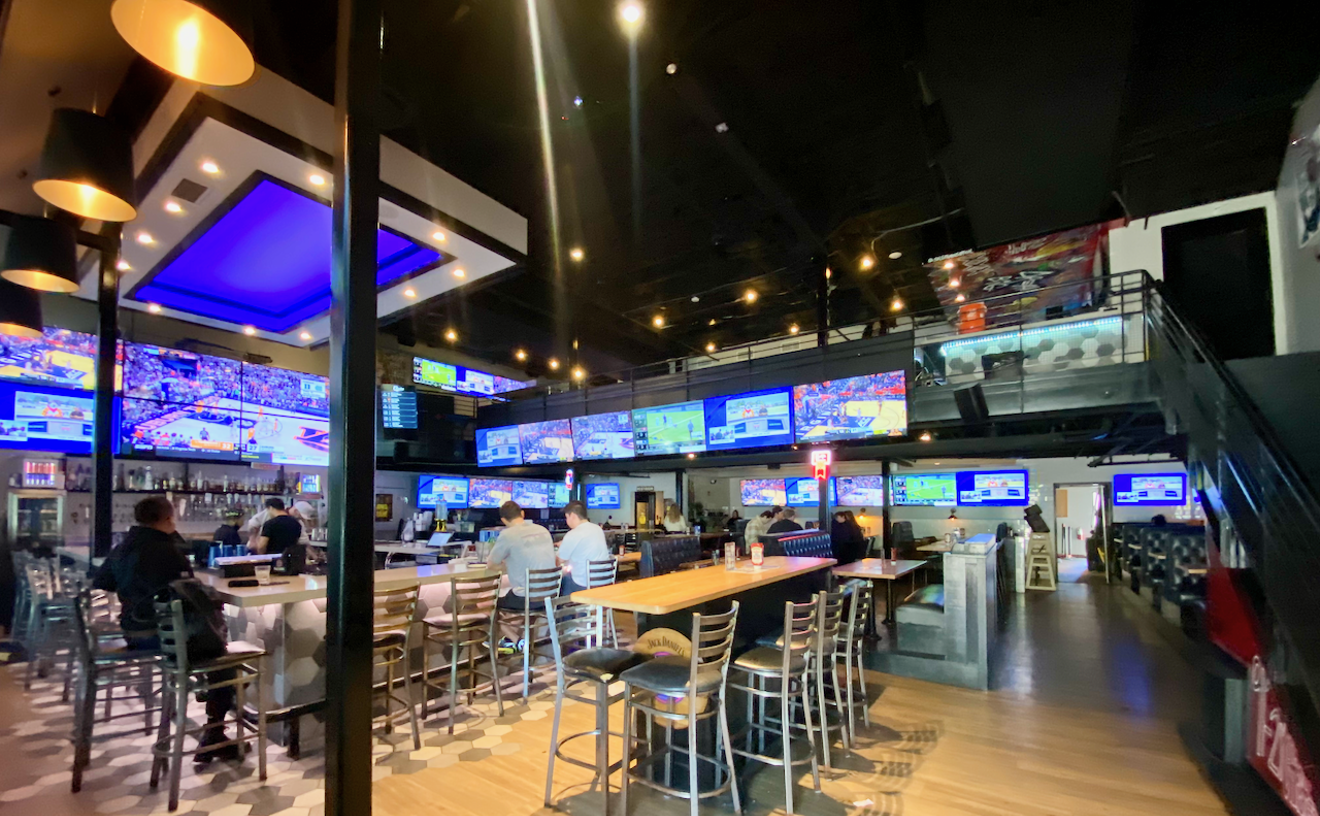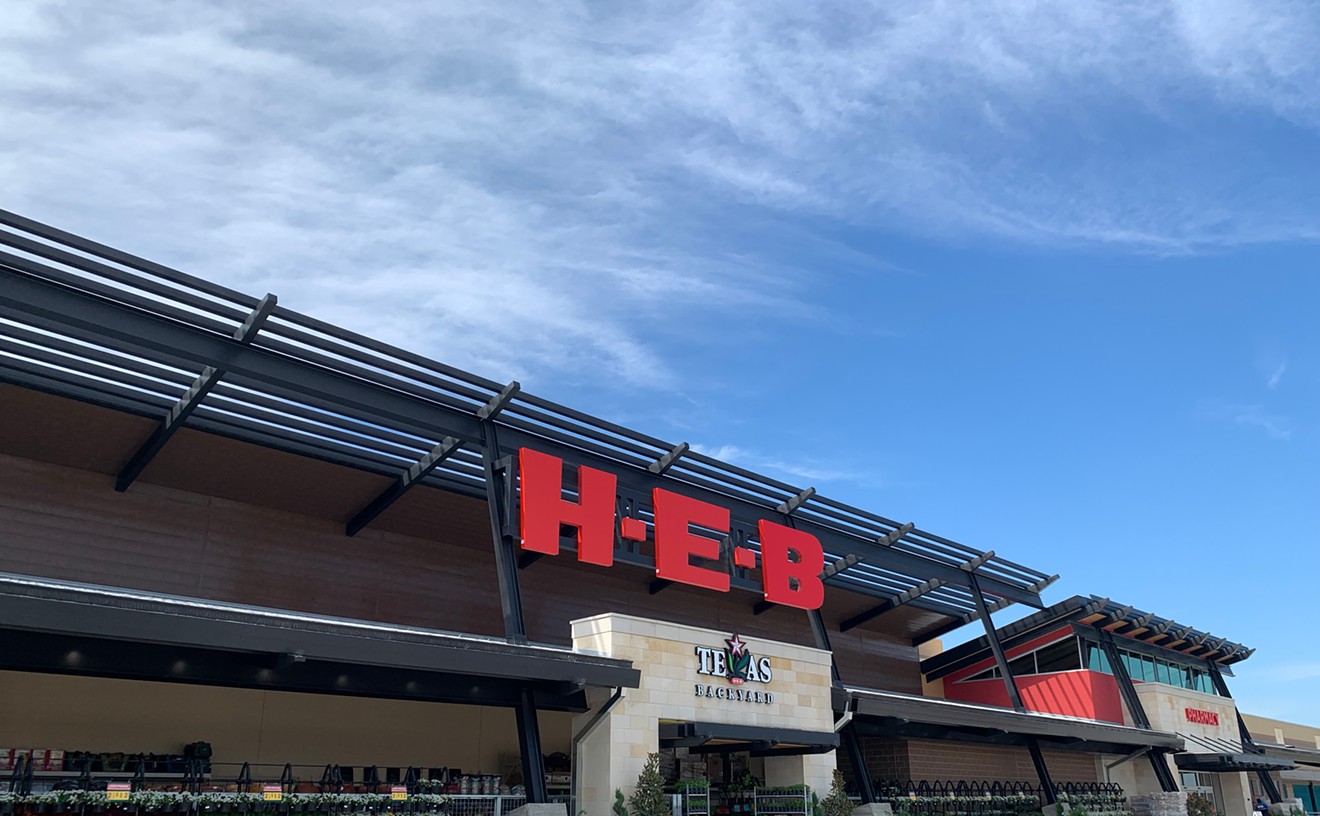So then why do the restaurateurs (McKinney city councilman Steve Bell and his wife, Sandra) crafting this innately attractive prison cum fine dining room maintain two ratty, full-sized figures of the Blues Brothers caught in midstride, running after an apparent jailbreak? Is this a hint that guests should perhaps follow their lead?
Hard to say. But even if you don't eat, this prison--or jail--converted into a restaurant has a history dusted with felonious spice. According to the menu blurb, Frank James, brother of Jesse James, had a stint within these sandstone walls. Murderer Ezelle Steppe was the last man hanged at the prison in 1922, over the space that is The Prison's "hang-out" patio. Inmate Frank Reese, whose photo hangs on the third floor of this restaurant, allegedly ate light bulbs, which doesn't say much for prison cuisine. Raymond Hamilton, a member of the Bonnie and Clyde clique, also did time in the Collin County can in 1932, a few years before the place was renovated with dough from the Public Works Administration. Hamilton escaped after less than a month of indulging in its "high Victorian Italianate," and maybe even its light bulbs.
There were a few times that I wanted to escape the place too. Fried green tomatoes were found under the heading "arresting appetizers." Five golden fried tomatoes lay on a bed of weeds next to a ramekin of roasted red-pepper garlic aïoli with a keen wisp of smoky, almost bacon-like flavor. The tomatoes were little more than sponge-mush Frisbees. One bite, and the interior leaked out as the fry casing disintegrated in my hand. On the second visit, the fried green tomatoes were far better: firm and crisp with structural integrity, though the green tomato slices had more blandness than bona fide flavor.
A salad dubbed the "slab" with "chain gang red onions and chives" was mediocre. The expectation here, at least the one cultivated by visits to Dallas steakhouses, is that of an elegantly tight wedge of iceberg lettuce oozing with milky dressing and trimmed with an array of tomato and onion. What arrived (with a choice of ranch or blue cheese dressing) was a loose and separating lettuce-head sheaf planted with cherry-tomato halves, rings of red onion, and long, uncut chives.
But the presentation was only a small problem because the ingredients tasted fine, we think. It's hard to tell because my companion and I were cautiously mulling The Prison martini, served in a huge glass, which could have damaged our taste buds. The beverage was ordered "dirty"--loaded with olive juice--but it arrived more polluted than soiled, necessitating a recall. Prison hands also do funny things with their olives. Ours were impaled with a swizzle straw instead of a cocktail pick, which might have been useful for picking cuff locks. Prison-issue frozen margaritas were a bit better, although the slush lacked consistency and projected an alarming shade of fluorescent green.
The Prison does have a decent wine list, although the whites are a little overburdened with chardonnays, and the reds bleed a little too much cab and merlot.
Yet, this is a prison, don't forget--and they won't let you. The entrance is secured with steel doors with revolvers as handles. The huge bar on the ground floor is encased with metal, like some sort of Dean Martin-fantasy confinement chamber. Small dining areas flank each of the first two floors, and ascension to the upper reaches of The Prison is accomplished via an old staircase with lumpy steps and a smooth white banister. Rooms and walls harbor a plethora of pictures, gimcracks, gadgets, and other penitentiary trifles such as rifles, pistols, brands, metal stars, and key rings.
But it's on the third floor where The Prison met our expectations. Each side holds an array of upholstered booths cordoned within metal webbing--little prison cells within which to nosh. Think how fortunate for us the refurbishers didn't overkill this novelty and convert the shower room into a dining area with soap bars on the floor.
And soap is exactly what the sautéed jumbo shrimp in white-wine butter sauce tasted like. The shrimp were fibrous, a little mushy, and soapy. The sauce attacked the mouth more like a slice of lemon than a sip of white wine.
Prison pasta looked as though it had been through a prison riot. Tossed with fresh vegetables and chicken, the rigatoni tubes were overcooked, fraying, and splitting down the middle. The Alfredo sauce was gritty coating for an uneventful pasta mélange of vegetables (zucchini, yellow squash, and broccoli) that littered the tattered tubes.
The seared chipotle molasses-glazed double-cut pork chop was better, though not by much. This thick slab of bone-in flesh was spongy and dry, yet tender. But it lacked that pinkish core that sweats copiously with clear juice, providing a medium to circulate the pork flavors. Plus, the molasses treatment was cloying without a savory counterpoint to break its weariness. A side of pineapple-whipped sweet potatoes was good, though, despite the name, there was no evidence of any pineapple pulp or flavor woven into thickened slurry.
Flavor was robust in the herb-roasted half chicken with cornbread stuffing. The dark bird was moist and tasty, yet the outside was flaccid--even a little slimy--as though it hadn't been torched long enough, though there was no sign of undercooking inside the bird.
Nothing was wrong with the 16-ounce Texas T-bone with pico de gallo strewn across its broad expanse. Nothing stood out either. Yet it was a surprise, given that its thickness barely reached half an inch, and the flesh was juicy and glistening at the perfect medium-rare hue--no small feat considering its thinness.
The Prison staff was friendly, if a bit inept. Servers prod incessantly, barely leaving you alone to stab and chew. Maybe they fear escapes. Pressure was brought to bear for a drink order. A squeeze was put on for chips and salsa or bread. We chose bread, thinking it appropriate, but it never made it to our table until close to the end of our meal.
Still, the food here is fine, just fine. The décor and the setting alone make it worth a stab. And if the food doesn't measure up to your standards, you can always bring your own cake.










